|
 |

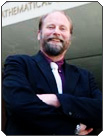 Edward L. Wright – WISE Principal Investigator - UCLA Edward L. Wright – WISE Principal Investigator - UCLA
Ned Wright grew up in Fairfax County, VA on land once owned by George Washington. He went off to Harvard for college, majoring in physics. After Harvard Ned went to the Physics Department at MIT and got involved in planning and designing the COsmic Background Explorer (COBE) and in using the the Kuiper Airborne Observatory (KAO). Seeking clearer skies he went to UCLA starting full time in 1982.
When the SIRTF (now Spitzer) science working group was selected in 1984, Wright was one of the two interdisciplinary scientists chosen. In 1998 Ned Wright and Peter Eisenhardt got together to setup a proposal team for what was then called the Next Generation Sky Survey (NGSS). When the Next Generation Space Telescope (NGST) became JWST, and TRW became NGST, NASA directed NGSS to choose a new name and WISE was born. [read full bio]
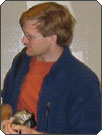 Andrew Blain– Caltech Andrew Blain– Caltech
Andrew Blain was born in Liverpool in the UK, and attended Cambridge
University. He moved
to Caltech in 2001, and has been involved with the development of WISE
as a tool for
studying the way the galaxies in the Universe formed and evolved, and
studying the evolution
and the development of the stars and gas within.
Using observations at the wavelengths where WISE will operate, some of
the most powerful
galaxies can be identified. These are the galaxies in which stars are
forming most rapidly, and
they should provide information about the most dramatic phases of the
Universe's history.
The trigger for these events, whether mergers with immediate
neighbors, or effects due to
their environments on wider scales, should shed light on the way in
which the cores of galaxies
form.
Other interests include gravitational lensing, models of
Non-scientific interests include food, chasing kids born in 2004 &
2006 and very occasionally
riding a bike further than the office. At some point he'll learn to
ski and fly. Better for the safety of
those below, while he does ski badly, he's not been trying to fly.
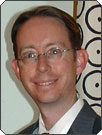 Dominic Benford– NASA/GSFC Dominic Benford– NASA/GSFC
Dr. Benford is an Astrophysicist in the Observational Cosmology Laboratory at NASA’s Goddard Space Flight Center in Greenbelt, Maryland. His research interests are in extragalactic astrophysics and cosmology and in infrared instrumentation development. He is the Deputy PI of the Destiny mission concept for JDEM, which seeks to characterize dark energy and its evolution over cosmic time. Dr. Benford is the Instrument Scientist for the SOFIA/SAFIRE far-infrared spectrometer. He has pursued research in continuum detectors for ground-based submillimeter observations, near-Terahertz heterodyne receiver technology, submillimeter observations of star forming regions and ultraluminous galaxies, and cryogenic instrumentation systems for space observatories. He has led and participated in several mission concept studies, including the SAFIR Vision Mission and the SPIRIT Origins Probe. Dr. Benford received his Ph.D. in Astrophysics from the California Institute of Technology in 1999 on the topic of "Broadband Submillimeter Instrumentation for the Detection of Distant Galaxies."
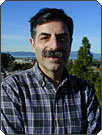 Martin Cohen– MIRA Martin Cohen– MIRA
Martin Cohen's ongoing research areas include planetary nebulae, the interstellar medium, late stellar evolution, Galactic structure, and ultracompact HII regions. He has 38 years of identification, spectroscopy and analysis of sources found in IR surveys; and 17 years of work in absolute IR calibration of ground-based, airborne, and space-based sensors. He has worked for many astronomical satellites: as a Science Team member of Japan's Infrared Telescope in Space; the US Midcourse Space Experiment's (MSX) Celestial Backgrounds Team; the European Space Agency's (ESA) designated US Calibration Advisor to its Infrared Space Observatory (ISO); as a Consultant to the UK's ISO Long Wavelength Spectrometer; worked on absolute calibrator stars for Spitzer's IRAC and IRS instruments; a member of the SAGE and GLIMPSE Spitzer Legacy teams.
In addition to WISE, he is a Science Team Member of Japan's AKARI mission, the UK Schmidt Telescope Unit Planetary Nebula Consortium, the Australia Telescope National Facility's 20GHz survey, and the HIGAL program of ESA's Herschel spacecraft. He is also an ongoing member of NASA's Astrobiology Institute through the Virtual Planetary Laboratory.
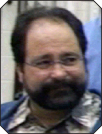 Roc Cutri – Caltech
Roc Cutri – Caltech
Dr. Cutri, IPAC Deputy Executive Director, was the data processing lead scientist for the Two-micron All Sky Survey (2MASS) project which involved about two dozen staff members from IPAC, for which he won the 2007 James Craig Watson Medal from the National Academy of Sciences.
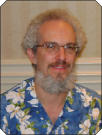 Peter Eisenhardt - JPL Peter Eisenhardt - JPL
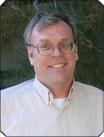 T. Nick Gautier - JPL T. Nick Gautier - JPL
 Thomas Jarrett– Caltech Thomas Jarrett– Caltech
Dr. Jarrett, a native Californian, joined the Infrared Processing and Analysis Center (IPAC) in 1991 after completing his BA in Physics from Pomona College and PhD in astrophysics from the University of Massachusetts. During his tenure at IPAC, Jarrett has performed hardware instrumentation, software engineering, and scientific research across a wide range of fields in astronomy. He helped to develop a near-infrared camera system for the Hale 200" Telescope of the Palomar Observatory, conducting research on young stellar objects, star formation regions and nearby galaxies. In 1994 he joined the Two-micron All Sky Survey (2MASS) and was charged with detecting, characterizing and cataloging extended sources. Using the 2MASS 'galaxy' catalogs, Jarrett has conducted research in the large scale structure that comprises the local universe. In 2003, he then joined the Spitzer Legacy teams "SINGS" and "SWIRE", focusing his research on star formation in low-redshift galaxies. Participating in and/or leading a number of Spitzer GO projects, Jarrett has studied interacting galaxies (notably the "Tadpole Galaxy"), clusters and large scale structure (notably the "Great Attractor"), and the most massive HI galaxy in the local universe (aka "The Coelacanth Galaxy"). Since 1999, Jarrett has also served in a teaching role as an adjunct professor at Pomona College, creating the course "Life in the Universe", while also serving as an adviser to senior undergraduate students.
He is currently the co-adviser to a University of Cape Town (RSA) PhD student who is now (2008) completing her dissertation. Jarrett is a participating member of the Spitzer IRAC Instrument Science Team, and is the cognizant software engineer for the WISE aperture photometry system. He is also a member of the Anglo-Australian Observatory Users Committee, and frequently travels to his favorite country Australia to work with his colleagues 'down under'.
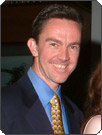 J. Davy Kirkpatrick - IPAC/Caltech J. Davy Kirkpatrick - IPAC/Caltech
Davy Kirkpatrick grew up on a dairy and tobacco farm in Hendersonville, Tennessee and studied at Vanderbilt University and the University of Arizona.
His close association with flatulent Guernseys prepared him well for a study of methane-bearing brown dwarfs, which is now his specialty. Brown dwarfs are the low-mass products of star formation. They lack a sustainable energy source and slowly fade with time, making them quite difficult to detect. It wasn't until the advent of all-sky surveys mapping infrared radiation ("heat") that the first brown dwarfs were uncovered.
It is now believed that they may be as numerous as the stars themselves.
Using the WISE data, Dr. Kirkpatrick hopes to determine this space density of brown dwarfs and to find the closest brown dwarf to the Sun, which may be closer to the Sun than the nearest hydrogen-burning star (Proxima
Centauri) or
may even be a companion
to the Sun itself. Kirkpatrick has been at Caltech since 1994, where he became a team member on WISE's infrared predecessor, the Two Micron All Sky Survey (2MASS). Kirkpatrick has recently written articles on low-mass stars and brown dwarfs for the Annual Review of Astronomy and Astrophysics and for the Princeton University Press textbook Stellar Spectral Classification.
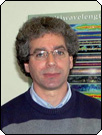 David Leisawitz - GSFC David Leisawitz - GSFC
Dave Leisawitz was born in Pottsville, PA, a coal-mining town potentially famous for hosting the oldest brewery in the nation. He wasn’t a big beer consumer when he left town at the age of 5 and shortly thereafter embarked on the path that led him to become WISE Mission Scientist. Along the way, Dr. Leisawitz picked up a PhD in astrophysics from the University of Texas at Austin, with Dr. Frank Bash as advisor, and then moved to NASA’s Goddard Space Flight Center as a National Research Council postdoc to analyze data from the Infrared Astronomical Satellite (IRAS) with Dr. Michael Hauser. After a brief stint on the research faculty at Penn State, Dave returned to Goddard as a civil servant, initially to develop and manage the Cosmic Background Explorer (COBE) guest investigator program. Along the way, he became COBE Deputy Project Scientist and adopted Dr. John Mather as a mentor. Working with John and others, including Dr. Ned Wright, Dave developed concepts for far-infrared interferometers. He is Principal Investigator for the Wide-field Imaging Interferometry Testbed, and served as PI for a study of the Space Infrared Interferometric Telescope (SPIRIT) mission concept and as Goddard study lead for the Submillimeter Probe of the Evolution of Cosmic Structure (SPECS), with Dr. Martin Harwit as PI. Dave mentors undergraduate and graduate students and postdocs who collaborate with him on interferometry and infrared astrophysics, and he enjoys devoting time to education and public outreach. In 2006, he became Chief of the Science Proposal Support Office at Goddard. He has served on three temporary assignments to NASA Headquarters, most recently as Acting Assistant Director for Policy and Planning in the Astrophysics Division. In terms of research, Dave is most keenly interested in the formation of planets and the development of habitable conditions in planetary systems. In the lab, he is developing an interferometric technique that will enable high angular resolution imaging and spectroscopy over a wide field of view for future space-based far-infrared observatories.
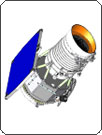 Carol Lonsdale - Caltech Carol Lonsdale - Caltech
 Amy Mainzer - JPL Amy Mainzer - JPL
Dr. Mainzer is a Research Scientist at JPL. After obtaining her B.S. in physics at Stanford, she took a year off after graduation to work at Lockheed Martin, where she worked on the Spitzer Space Telescope. She was the Principal Investigator of a cryogenic camera called the Pointing Calibration and Reference Sensor (PCRS), which serves as the fine guidance sensor for Spitzer. She worked on Spitzer during graduate school in astronomy at Caltech. After receiving her M.S. at Caltech, she finished her Ph.D. at UCLA with Dr. Ian McLean. For her thesis, she built the First Light Camera for SOFIA (FLITECAM) and observed brown dwarfs with it. She received her Ph.D. in 2003 just before Spitzer’s launch. The PCRS was the first camera to see light on Spitzer and has been operating since 2003. She joined the WISE team and JPL in 2003. As the WISE Deputy Project Scientist, she works to ensure that WISE will meet its science requirements. She is also the principal investigator of a project to enhance WISE’s ability to find new asteroids. Dr. Mainzer is looking forward to learning more about the universe with WISE, and in particular some of her favorite topics: brown dwarfs, asteroids, young stars and planets, and debris disks.
 John Mather - NASA/GSFC John Mather - NASA/GSFC
 Ian McLean - UCLA Ian McLean - UCLA
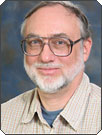 Robert McMillan– University of Arizona Robert McMillan– University of Arizona
Dr. McMillan is in charge of the Spacewatch survey of the solar system for near-Earth asteroids, main-belt asteroids, Centaurs, comets, and Trans-Neptunian objects. McMillan's career has included studies of variable stars, statistics of stellar populations, interstellar dust, interstellar magnetic fields, planetary atmospheres, Doppler shift spectroscopy of stars, astronomical instrumentation, and surveys of asteroids. He has worked in the last four disciplines while at the Lunar and Planetary Laboratory at the University of Arizona. [read full bio]
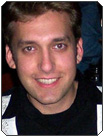 Bryan Méndez - UC Berkeley Bryan Méndez - UC Berkeley
Dr. Méndez received a Ph.D. in Astrophysics from UC Berkeley in 2002 and is currently an E/PO Specialist for CSE@SSL. He collaborates with schools of education, science departments, NASA missions, school districts, science centers, museums, and planetaria. Dr. Méndez has developed high quality, customer focused E/PO products and services, facilitated scientist involvement in E/PO, and participated in events communicating science to the public for several NASA missions and projects: including RHESSI, STEREO-IMPACT, CHIPS, WISE, and ROSES projects such as Stardust@home, the Automated Planet Finder, and Nature’s Biggest Blasts. He has strong interest and experience in teacher professional development and has conducted many workshops and short courses for teachers at CSE@SSL and at conferences such as NSTA, CSTA, & SACNAS.
Dr. Méndez also has extensive previous experience in education and public outreach activities including the following: Instructor for UC Berkeley’s Astronomy Department, teaching classes in introductory astronomy for undergraduates and leading education seminars for new graduate student instructors; Instructor of students in grades 9-12 for UC Berkeley’s Academic Talent Development Program, and a grades 4-6 classroom volunteer in ASP’s project ASTRO since 1998 through the present. As the WISE Deputy E/PO Lead, Dr. Méndez will manage, oversee, and participate in all aspects of the WISE E/PO program. He will also take leading roles in the teacher professional development, curriculum development, Asteroids@home, and all Public Outreach program elements for WISE E/PO.
 Deborah Padgett - Caltech Deborah Padgett - Caltech
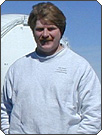 Michael Ressler - JPL Michael Ressler - JPL
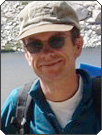 S. Adam Stanford - UC Davis S. Adam Stanford - UC Davis
Stanford received his Ph.D. at UW-Madison in 1990, and had postdoctoral positions at UC-Berkeley, JPL, and Lawrence Livermore National Laboratories, where he is still a participating guest. Stanford is most interested in galaxy formation and evolution, particularly within clusters of galaxies. He conducts multiwavelength observational programs both on the ground at the Keck Observatories and Kitt Peak National Observatory and with the space telescopes of NASA in order to find the most distant galaxy clusters and then use them to probe the effects of the dense environments on galaxy evolution.
Stanford will be working on the calibration of WISE data, and plans to
use
WISE data
to assemble an all-sky sample of moderate redshift galaxy clusters. In
addition to
its large size, the cluster sample will have the advantage of being
selected by stellar
mass, so it will provide an excellent means with which to study the
growth
of massive
galaxies in the most dense environments.
 Michael Skrutskie - University of Virginia Michael Skrutskie - University of Virginia
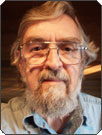 Russell Walker - MIRA Russell Walker - MIRA
Russ Walker’s primary scientific interest is the study of small bodies in the Solar System. He brings a diverse background in infrared astronomy to WISE. He did his undergraduate and masters work in physics, small particle scattering, and molecular spectroscopy at the Ohio State University, and completed a doctorate in astronomy at Harvard University, where he was co-author of the first paper to be published in the Astrophysical Journal on the infrared detectability of advanced extraterrestrial civilizations.
Russ has designed and built infrared and optical photometers, interferometers for Fourier transform spectroscopy, and liquid helium cooled infrared telescopes for operation in space. His passion has been performing infrared all-sky surveys and, more recently, the study and exploration of asteroids, comets, and cometary debris trails. He was awarded the NASA Medal for Exceptional Scientific Achievement for his work as Telescope Scientist for the Infrared Astronomical Satellite (IRAS), and his analysis of the IRAS comet data. He was Co-Investigator on the MSX Satellite Celestial Team responsible for planning and executing observations of the zodiacal cloud and minor bodies within the Solar System. He was also a member of the MSX/SPIRIT III performance assessment team responsible for the calibration of the MSX infrared observations. Russ is presently a research astronomer at the Monterey Institute for Research in Astronomy (MIRA) where he continues to pursue his space astronomy interests as a member of the science team for WISE, the next generation infrared sky survey.
|
 |




 Amy Mainzer - JPL
Amy Mainzer - JPL
 Robert McMillan– University of Arizona
Robert McMillan– University of Arizona  Bryan Méndez - UC Berkeley
Bryan Méndez - UC Berkeley  Michael Ressler - JPL
Michael Ressler - JPL
 S. Adam Stanford - UC Davis
S. Adam Stanford - UC Davis
 Edward L. Wright – WISE Principal Investigator - UCLA
Edward L. Wright – WISE Principal Investigator - UCLA  Andrew Blain– Caltech
Andrew Blain– Caltech  Dominic Benford– NASA/GSFC
Dominic Benford– NASA/GSFC  Martin Cohen– MIRA
Martin Cohen– MIRA  Roc Cutri – Caltech
Roc Cutri – Caltech Peter Eisenhardt - JPL
Peter Eisenhardt - JPL  T. Nick Gautier - JPL
T. Nick Gautier - JPL  Thomas Jarrett– Caltech
Thomas Jarrett– Caltech  J. Davy Kirkpatrick - IPAC/Caltech
J. Davy Kirkpatrick - IPAC/Caltech  David Leisawitz - GSFC
David Leisawitz - GSFC  Carol Lonsdale - Caltech
Carol Lonsdale - Caltech  Russell Walker - MIRA
Russell Walker - MIRA